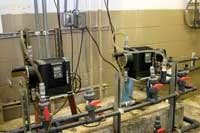Many things have changed since the town of Grants Pass’ early days as a stagecoach stop in the Rogue River Valley of southern Oregon. Though there are few reminders today of the many mining towns that sprang up in the area, the river that runs through it continues to be a source of water for the area’s modern inhabitants.
It was in 1888 that the City of Grants Pass first tapped the river as its sole source of water. Today, the population of Grants Pass stands at around 31,000. The Rogue River still serves as the town’s only source of water.
In 1906 the Rogue River Water Company (today known as the City of Grants Pass water filtration plant) pumped water directly out of the Rogue River and used chlorine to kill bacteria, though no filtration was used. Today, the City of Grants Pass’s treatment facility, constructed in 1931, is fully modernized and is recognized by the AWWA as National Historic Water Landmark.
Water piped from the filtration plant is pumped by 14 remote booster–pumping stations and stored in eight reservoirs located throughout the city. This distribution system is made up of five distinct pressure zones that change as elevation increases.
Today the plant uses a variety of chemical, sedimentation and filtration processes to remove particulate and pathogens from the water supply.
“As a 20 MGD water treatment facility, with a little more than 10,000 residential and commercial service connections, we’re really not that unique,” said Jason Canady, supervisor of the water filtration plant. “We take water from a natural source, the river, clean and distribute it for use in one of Southern Oregon’s larger communities.”
What does make the water filtration plant unique is the fact that, under Canady’s and his predecessor’s guidance, the community’s treasured, 76–year–old facility has been judiciously cared for and modernized from the inside out. Canady, who has served at the water filtration plant for 5 ½ years, has led the effort to update technology and processes there.
Canady recalls that, a few years ago, they began to experience difficulties at the filtration plant. Though they weren’t immediately sure of the cause, it was clear that there were unwanted variations in the level of treatment chemicals being introduced into the water stream.
“Ultimately, the quality of water we distributed wasn’t compromised, but it complicated our ability to provide it,” said Canady. “Fortunately, new technology has played a key role in helping us solve the problem, enabling us to reliably provide cleaner, safer water.”
For years, the plant had been using motor and belt driven feed pumps to add incremental amounts of treatment chemicals into the flow of water processed at the facility. Problems had developed, chiefly with the injection of coagulants immediately after raw river water exited the plant’s intake structure.
“We found that the old motor drive feed pumps at various dosing stations throughout the plant drifted a lot,” Canady said. “This complicated our ability to treat the water properly because we were getting very inconsistent results, especially at slower feed rates. Due to their age the pumps needed to be replaced and so we began a very rigorous process of installing and monitoring candidate pumps.”
“The ongoing challenge is to optimize the process to reduce chemical, energy and manpower needs,” he said. “As a result of process changes, we had significantly reduced chemical doses from the original design and have been operating at the lower feed rate limits of the existing pumps.”
At the water treatment facility, three obsolete, 22 year–old DC drive, BIF dual–head diaphragm pumps were replaced by DME 150–4 (150 liters per hour/LPH or 39 gph) Grundfos pumps.
“The old SCADA system matched the speed of the pump to the water flow and the chemical dose was set by manually adjusting the stroke length setting on the pump,” Canady said. “The operators had to go to each pump to make the adjustment. The motor had to maintain a minimum speed setting to prevent chemical solutions bleeding past their check valves, a problem we encountered especially during low flow periods.”
Canady had tried one of the small capacity DME units a few years ago on a trial project. He contacted Greg Brown, Pacific Service & Supply Co., a local supplier, who set Canady up as a beta tester for the larger DME units.
“At first we were skeptical, but we knew there had to be one pump to cover the wide dosing range that we demanded, so we were open to the recommendation given to us by Greg Brown,” he said. “When we installed the first of the new dosing pumps, we knew that we were on the right track. It impressed us enough to try a larger unit on a trial basis.”
The first of the 110 vAC single phase pumps performed flawlessly, and offered an 800:1 turndown.
“It was able to match our low flow demand while the pump it replaced couldn’t turn down enough to reliably meet our minimum demand. Some of the test pumps required a tubing change or other maintenance during the test period, while the Grundfos digital dosing equipment required no attention at all,” said Canady.
“The digital dosing pumps can act as a small pump initially and then be adjusted to full capacity later,” he said.
As an example, the 39 gph pump could be re–scaled to meet a maximum output of 20 gph. Then, a few years down the road, the maximum output can be raised as demand increases, perhaps due to increased flow to the plant.
“With a push of a few buttons, they can now reduce the maximum output of the pump to match the exact chemical feed rate needed at the plant,” Brown said. “Since a single pump model has a huge range, the same pump can be used for other applications that require a different dose.”
The digital dosing pump discharges are continuous except for a very brief, rapid fill stroke, so the chemical flow is provided at a much more even feed than solenoid or motor driven units.
A key advantage with the new pumps, if used for hypochlorite dosing, is that the vent valve can be connected to an integrated fail alarm which allows the pump to re–prime itself in an off–gassing situation.
An accessory to the pump provides a digital monitor of system performance, and failure condition. If the pump should fail to send measured chemical solutions into the process water, the “call for help” notifies the operator by phone, fax, email or PLC input.
“We also like the accessibility of the side–mounted controls, permitting us to see the digital display,” said Canady. “There’s also an easily–removable check valve cartridge, making maintenance or replacement easy.
“The accuracy of operation, however, is most important of all,” he said. “We’re most impressed with the Grundfos pump’s easy calibration procedure. We used this capability to fine–tune dosages, and the measurement of treatment chemicals delivered was exact, and stayed that way.”
Primary Chemicals used For Treatment at the Grants Pass Filtration Plant Include:- Chlorine – fed as 12.5% Sodium Hypochlorite (Bleach) used for disinfection.
- Liquid Alum – primary coagulant used to remove particulate from the water.
- Polymer – used as a coagulant aid.
- Hydrated lime – used to balance the pH of the water. This helps to control corrosion in the distribution system.





